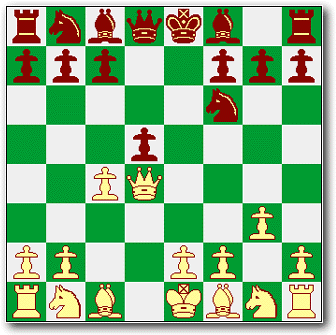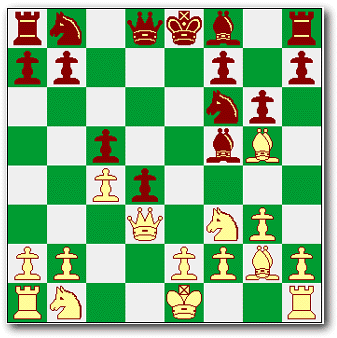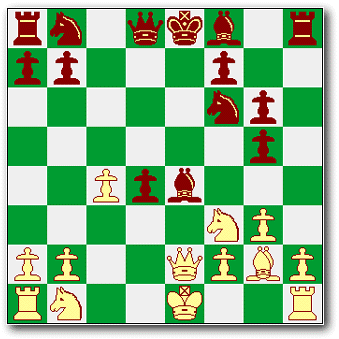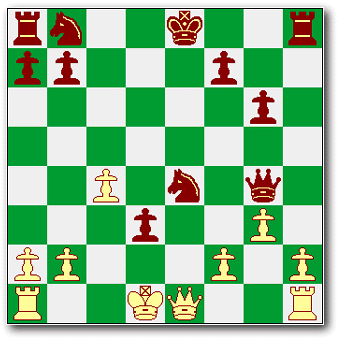June 8, 2000
Game Five
White: Allen Starfy
Black: Ty Davison
Opening: A20 English O
E-mail, Game 5, 1997
Ty: This was a very exciting game! Al played an obscure Russian-line of the English opening which, despite its unfortunate result in this game, looks to me to be a very sharp and very playable variation.
Al: Ah, once again I lose to you...and this time my game was so bad it will take a couple of days to air out the house. Anyway, the first 3 moves came from a 1991 game in Brussels between Ivanchuk and Yusupov. I take credit (blame) for all of the moves past that point.
1. c4
Ty: Ah, the English. Essentially one of those funky "hypermodern" openings (though I believe it's of relatively old vintage) where White doesn't directly attack the center, but instead attempts to influence and/or control the middle squares instead. We were here in game 3.
1. ... e5
Ty: ...and I played this same 1. ... e5 with good results. If White doesn't want the center, I'll take it.
Al: This treats the defense as if it were a Sicillian in reverse.
2. g3
Al: This is called the English Opening/Accelerated Fianchetto Variation. The strategy behind it is control of the light squares.
Ty: Whoa! This is weird. Sure, you fianchetto Kingside, but I'm not used to it this early.
2. ... Nf6 3. d4
Ty: And now we're out of book entirely. That was fast. Personally, I find 3. d4 very strange, though strange is not the same as "bad." There's plenty of life in this line.
Al: While it looks odd, the idea is for White not only to grab a piece of the center, but that he should have an easier game due to a space advantage which will give his pieces better mobility.
3. ... exd4
4. Qxd4
Ty: This surely must have been planned, but it violates one of the cardinal rules of development which is don't push your Queen too far too soon. It will cost black a tempo when the Queen retreats, and more than likely Black will own the center (which, since this is a hypermodern opening, isn't as terrible as it might otherwise be).
4. ... d5

5. Bg2 c5
Ty: White's biggest advantage right now is his fianchettoed bishop. Black may have to do a little tap dance to free his a8 Rook. At the same time, Black will get that chance because of the gained tempo from the over-extended Queen, which, again, must be part of the line.
6. Qd3
Al: Should have pulled the Queen back to d1.
6. ... d4
7. Nf3 g6
Ty: If White can fianchetto, hopefully Black can too. I'm also going to use g6 as a lever for my Bishop to attack White's still over-extended Queen. Now if White plays 7. 0-0 then 7. ... Bf5. When the Queen moves off, I'll play a Be4 which pins the Knight. If White breaks the pin, then I trade white-squared bishops to kill White's run of the long diagonal.
8. Bg5
Ty: This is much more aggressive than Al normally plays. I should have plenty of chance to break the Knight-Queen pin, but I really expected 0-0 here. Regardless, this does nothing to stop my own plans of world domination beginning with...
8. ... Bf5
Ty: The Queen is forced back again, gaining me another tempo. I'm not sure what the line is from the Russians, but it should include "get the Queen out of the middle as soon as possible." 4. Qxd4 has cost White two tempi after only 8 moves. Note also that White's influence over the central four squares (d4, d5, e4, e5) is dropping as the Queen moves off. On move 4, White could claim possession or control of 2 of 4 squares with the other two contested (by Black's f6 Knight). By the end of move 9, Black will possess 2 of the 4 squares, contest d5 and have e5 behind its "shield." Since maintaining central square control (not necessarily possession) is crucial to success in a hypermodern opening, this does not bode well for White.
At the same time, I've got my plate full with four different issues going into move 9. First, I need to block the fianchetto of the g2 Bishop, something I could accomplish via 9. ... Be4 or maybe 9. ... Nc6 or 9. ... Qd6 which both control e5 (though White could play 10. Nh4, I suppose). Interestingly, Qd6 is probably better than Nc6 because it breaks the pin from White's Bg5, which is the second problem. The third and fourth problems are fianchettoing the f8 Bishop and castling the King. That's at least four moves to complete development and not an easy task.

9. Qd2?
Al: I lose another tempo saving the Queen.
Ty: A dubious move, I think because it blocks the b-file Knight from attacking e4. With c3 already under Black control, the Knight will have to develop along the a-file.
UPDATE: The correct move here, as submitted by Richard of East Yorkshire is 9. Qb3! threatening Qxb7. Black's best response appears to be 9. ... Bc8, but the only playable lines left for Black after that are 10. Ne5 Nbd7 11. Nxd7 Kxd7 12. Qa4+ Kc7 and 10. Ne5 Bd6 11. Qb5+ Nbd7 12. Nxd7 Bxd7 13. Qxb7 0-0. Of the former, Richard said, "This is the only way...Black can reach a playable game with equal material." Of the latter line, Richard noted, "Black has compensation for the pawn because white is looking dangerously underdeveloped. This is virtually black's only chance for a win."
9. ... Be4!
Ty: I played 9. ... Be4 here because it pins White's Knight to his fianchettoed Bishop. That eliminates the need to control e5 right away. The problem with 9. ... Qd6 is that White can force the Black Queen into a trade or a retreat through 10. Qf4! This way I can meet 10. Qf4 through 10. ... Be7 (protecting the Knight and breaking the Queen pin). Better still might be 10. ... h6.
10. e3?!
Al: While I liked it at the time, 10. Nc3! would probably have been a better choice.
Ty: I didn't see during the game, but you're absolutely right, Al, about 10. Nc3! It would've been a terrific move--perhaps even a game winner. While 10. e3?! looks sickly in comparision, I'd just put it down as a move of questionable value, not an outright mistake. At the same time, it does nothing to solve White's positional and developmental difficulties, which are multiplying. Indeed, e2-e3 blocks the interesting play of Qf4!, so the kingside is now almost entirely closed down for White. Note also that Black's best response to e3 is to ignore it. 10. ... dxe3?! weakens Black's central position dramatically (and allows 11. Qxd8 which kills Black's chance of castling). Also poor is 10. ... d3? because while it establishes a deep pawn outpost, it allows White's b-Knight into the action untouched, particularly with something like 11. Nc3! which lowers the boom on Black's very effective e4 Bishop.
10. ... h6
Ty: This is called "putting the question to the Bishop." Now White will have to attack or move. White's best response is probably 11. Bxf6 but he'll still need to find a way to attack Black's e4 Bishop.
11. exd4
Ty: I must confess to being amazed at White's willingness to sacrifice the Bishop to gain central control and a little time, but it's not a bad move. There's plenty of counterplay, and equalizing chances are available. Black can either fight for the center with 11. ... cxd4 or take the Bishop with 11. ... hxg5.
11. ... hxg5
Ty: If this were strictly about material, I'd be inclined to leave White's Bishop en prise and fight for the center. But taking the g5 Bishop solves one of my four problems, with White's fianchettoed bishop, fianchettoing my own Bishop and castling to safety remaining. And now if I can trade piece-for-piece into the endgame, the extra Bishop should be enough to win.
White's still got severe kingside problems here, though 12. Qxg5 may provide a partial solution at the expense of some central control. Nonetheless, I expect to see 12. dxc5 or 12. d4. Either way, my response will be to force the kingside issue with 12. ... g4.
12. Qe2!
Ty: Al surprises me yet again, this time with a really great move. This is easily the most aggressive game he's played and as a consequence this could be a real slugfest. Here, he both applies pressure to Black's e4 Bishop, clears d2 for the b1 Knight, and pins Black's King. My plan of 12. ... g4 is out the window.
Al: While I thought this a great move, a Knight on c3 would have possibly been better in the long run.
Ty: Agreed, though once again, I missed it as a viable move during the game.
12. ... cxd4
Ty: There are really only three acceptable responses to White's excellent 12. Qe2! and 12. ... cxd4 is the best. This clears the a3-f8 diagonal for Bb4+, maintains a central presence (also potentially winning a tempo via 13. ... d3) and grabs a pawn. The other two options, 12. ... Qe7 and 12. ... Kd7!? look to me to lead to equality, with White having the potential of making up for his sacrificed Bishop. 12. ... cxd4 should allow Black to maintain his slight material advantage. White's best response here is 13. 0-0 or 13. N(b)d2.

13. Nxg5?
Al: Nothing but a mistake. Black is still ahead a Bishop and a pawn for 2 pawns and now my Knight is in a bad spot.
Ty: Premature. White's still got his King exposed, and that's never a good time to launch an attack. The problem is that what locks Black's e4 Bishop is the pin from White's Queen. If that pin gets broken before White's g2 Bishop can take with Bxe4, then the sword cuts both ways and Black can play Bxg2.
13. ... Bb4+
Ty: Castling isn't an option while under check, so White can either move the King and forgo castling entirely (which is not recommended since it leaves the King in the middle of the board relatively unprotected), or White can block with 14. Nd2 (not 14. Nb3? which leads to 15. cxb3 and opportunities for Black to queen a pawn). In terms of Black's development, I obviously won't be fianchettoing this game, so castling my King and dealing with the g2 Bishop remain my only two problems.
14. Nd2 d3
Ty: Now we put the question to the Queen. With the exception of d1, everything is treacherous for the Queen along the d1-h5 diagonal. In fact, there are but three acceptable moves to preserve the Queen: d1, f1 or e3. Of these, e3 is easily the best as it maintains the crucial e4 Bishop-King pin, though 15. Qe3 Bc5! 16. Qxc5 Bxg2.
15. Qf1?
Al: Not sure what game I was playing but this move definitely didn't belong in this game.
15. ... Bxd2+
Ty: Breaking the e4 pin was an unfortunate choice, and White will pay as a result. His King can now only move Kd1 or Kxd2, but either way he won't be castling in this game and the Knight on g5 is toast.
16. Kxd2
Al: My intention all along had been to castle long which I felt would give me a great advantage. Positional mistakes have now made this impossible.
16. ... Qa5+

17. Kd1 Qxg5
18. Bxe4
Ty: White launches his long-delayed fianchettoed Bishop. Unfortunately, he's no longer much of a threat to Black's a8 Rook and all his protection surround e5 has either been gobbled or forced to move off. My Knight will take care of this Bishop and castling my King remains my only developmental problem.
Al: In this position f3 would have been a wiser choice.
18. ... Nxe4
Ty: This is one of those interesting positions that one occasionally arrives at in chess where the options available look far greater than they really are. White has 20 potential moves he can make in response to 18. ... Nxe4, but he must be very careful here as all but two moves lead to 19. ... Qd2++ or 19. ... Nxf2 which forks the King and Queen. Only 19. Qe1 or 19. f4 are "safe," but both ultimately hold unsavory complications for White's Queen.
19. Qe1
Al: ChessMaster 5000 called this the "Yikes!" position which I think is the polite way of saying "Your game has died and is smelling up the room."
19. ... Qg4+
Ty: White has three options (Kc1, Qe2 and f3), all of which lose the Queen within three moves. Notice that Black has done nothing but attack since move 8.

0-1 White resigns.
Ty: An aggressive game with a very sharp (and very obscure!) English opening variation. White had some problems getting counterplay even after a valid Bishop sacrifice probably because the aggressiveness called for in this style of game. Had this been an obscure line in a slower, more quiet opening, White's chances would've been dramatically improved because Al's game typically shines in those situations.
|





